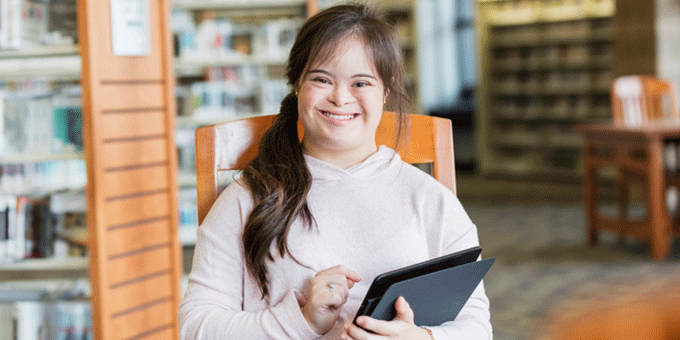ASDAN provides accessible pre-Entry level to Level 3 courses for young people with additional needs in over 30 different countries and territories. We’re passionate about putting the learner at the heart of our developments.
ASDAN is a leading curriculum organisation, providing ready-made resources and schemes of learning to support teachers to deliver its courses and gain the best outcomes for all learners.
So, what does ‘accessible’ mean to us as an international provider of educational materials? Well, we firmly believe that accessible design is good design for everyone, and we’re constantly seeking ways to address and eliminate barriers to learning.
ASDAN regularly updates our programmes to ensure that the materials can be tailored to individual learners’ needs, both in the course design and content.
Practical, person-centred programmes
It’s been a busy few years for ASDAN’s in-house Programmes Design and Development (PDD) team, who work closely with our members and are trained in best practice approaches to curriculum design and delivery.
In 2020, we updated our Personal Progress qualifications including nine new units dedicated to learners with Profound and Multiple Learning Difficulties (PMLD).
In collaboration with the National Development Team for Inclusion (NDTi), we launched My Independence – our innovative suite of programmes mapped to the preparing for adulthood pathways for young people with education, health and care plans.
In 2021, we updated our flagship Personal Development Programmes, including 193 challenges and over 60 resources supporting both tutors and learners.
Accessible design checklist
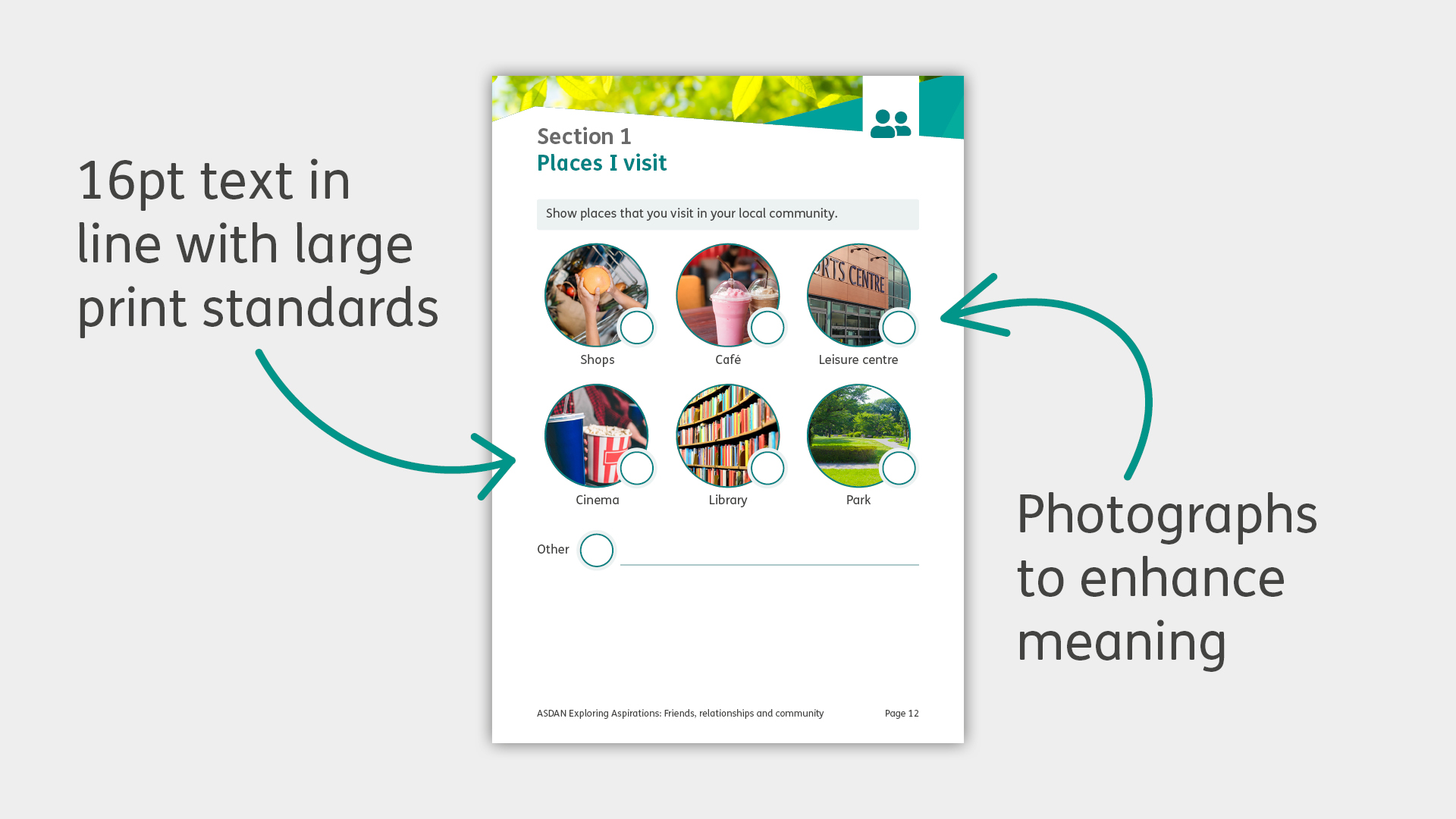
The following list is a snapshot of the design elements considered when creating and updating all ASDAN materials:
- Increased font sizes
We create our designs using a minimum font size of 12pt, in line with clear print guidelines. In materials where the audience is learners with SEND, such as our My Independence courses, we increase this to 16pt, the minimum size for large print.
- Clear, easy-to-read layouts
We design page layouts that are well-spaced and easy. We use outlined boxes, dividing lines and tables to display content in more manageable chunks.
- Clear and legible typefaces
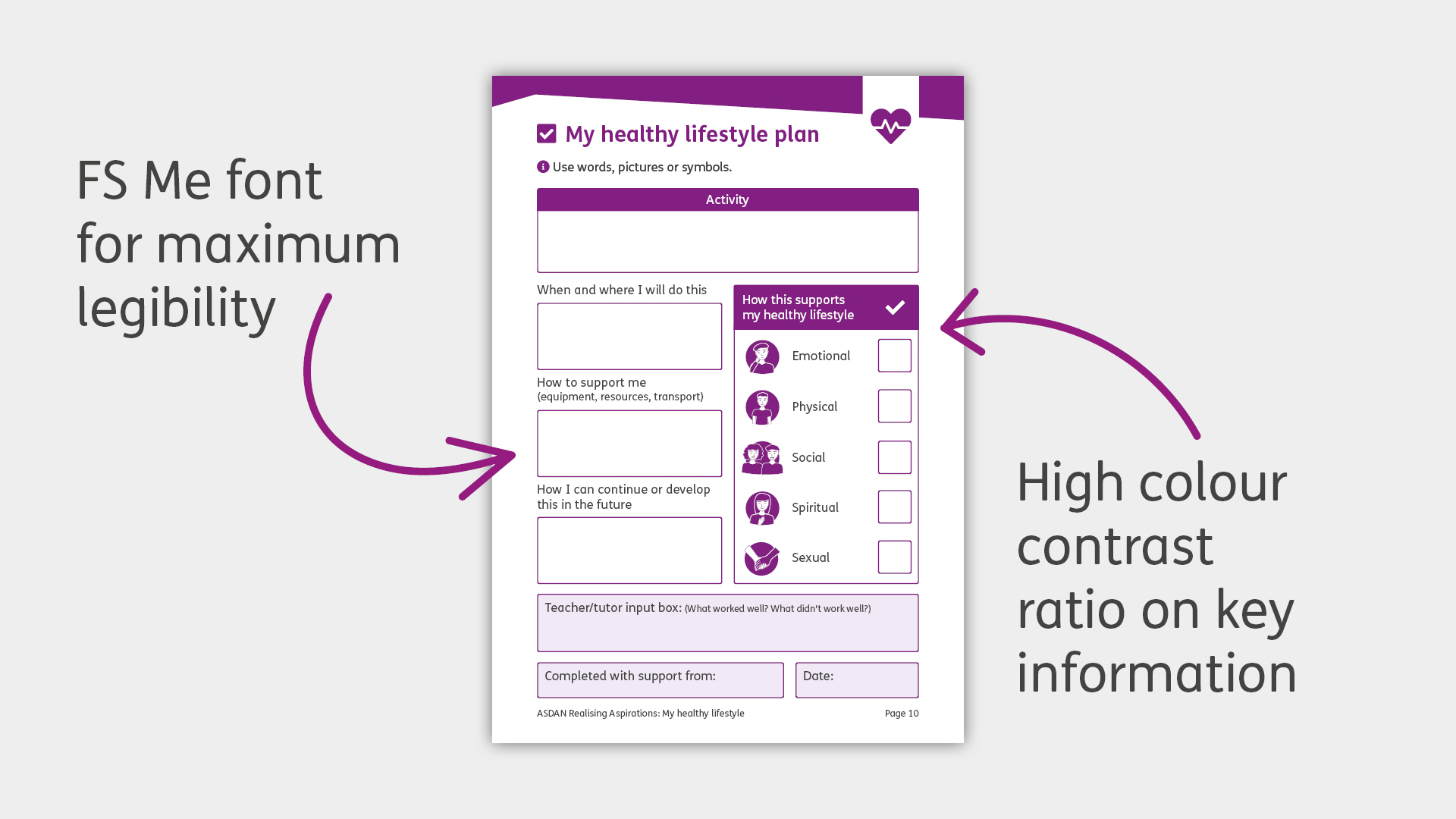 Our design team love to talk typefaces. ASDAN’s main brand typeface is Muli, as it’s designed to be easy to read – with a single storey lowercase ‘a’ and handwriting style lowercase ‘g’. For projects where the main audience is learners with SEND, we use FS Me, a typeface designed by Fontsmith in partnership with Mencap, specifically for those with learning disabilities. This typeface is used in My Independence – our latest suite of programmes for learners with SEND.
Our design team love to talk typefaces. ASDAN’s main brand typeface is Muli, as it’s designed to be easy to read – with a single storey lowercase ‘a’ and handwriting style lowercase ‘g’. For projects where the main audience is learners with SEND, we use FS Me, a typeface designed by Fontsmith in partnership with Mencap, specifically for those with learning disabilities. This typeface is used in My Independence – our latest suite of programmes for learners with SEND.
- Accessible colour palette and high colour contrast
We carefully choose colours with enough contrast to keep key elements and wording easily visible, working towards Web Content Accessibility Guidelines AA and AAA standards. We also avoid using colour as the sole indicator or using colour alone to convey meaning so our content is accessible to those with colour vision deficiency.
- Meaningful and engaging imagery
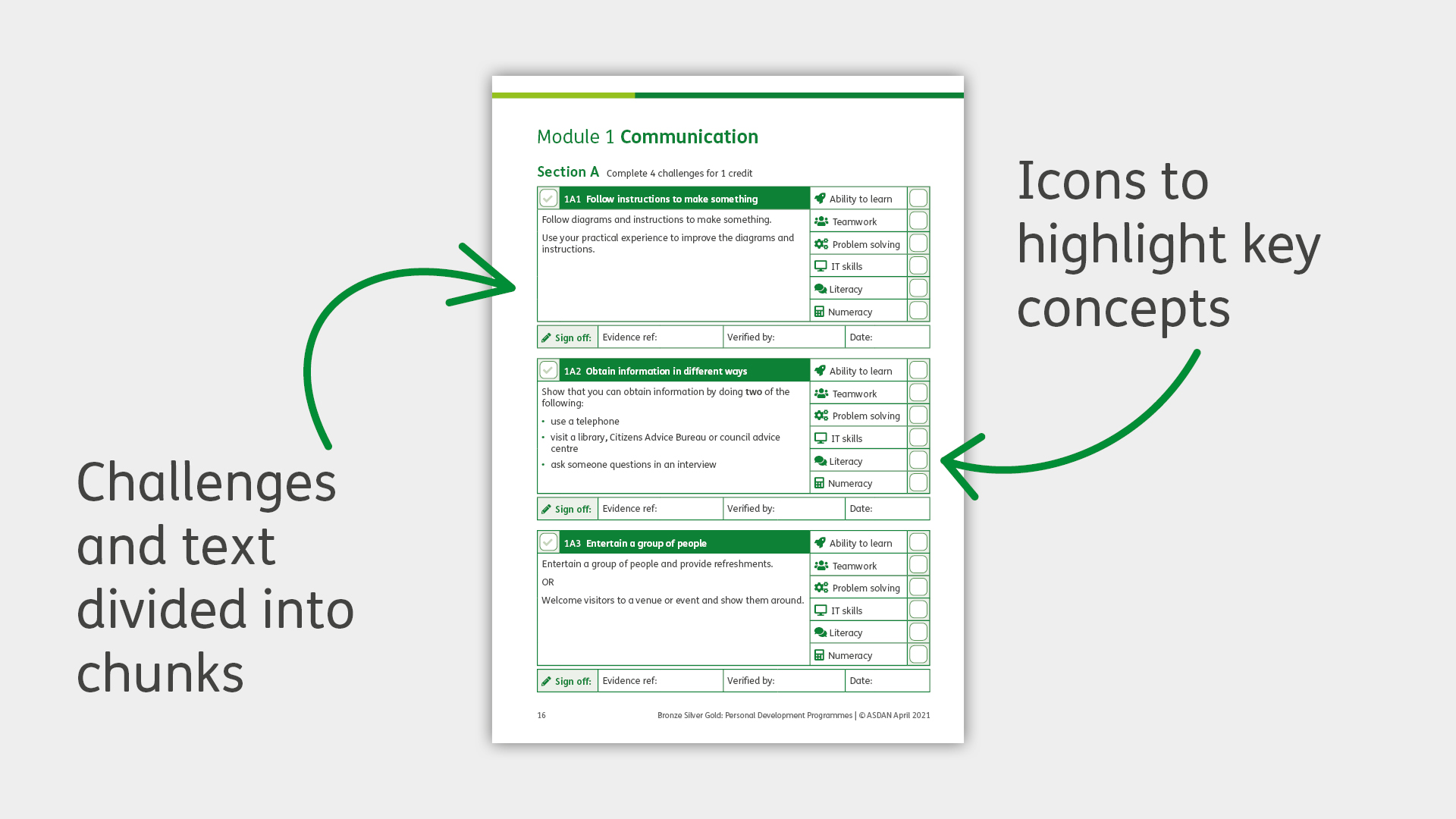
We choose images carefully – whether photographs, icons or illustrations, we only use imagery that reinforces the content and has meaning. We select photography that minimise bias and promote equality, focussing on real-life and practical activities and choosing authentic and aspirational images that are diverse and inclusive in terms of gender, ethnicity and disability.
- Alternative document formats
We design our printed materials, in a way that makes them most accessible to most learners. We recognise that many learners will have specific needs, so we’re starting to make ASDAN materials available in alternative formats to enable our members to make any needed adjustments. For example, the recording documents and supporting resource templates for PDP are available in PDF, Word and PowerPoint format.
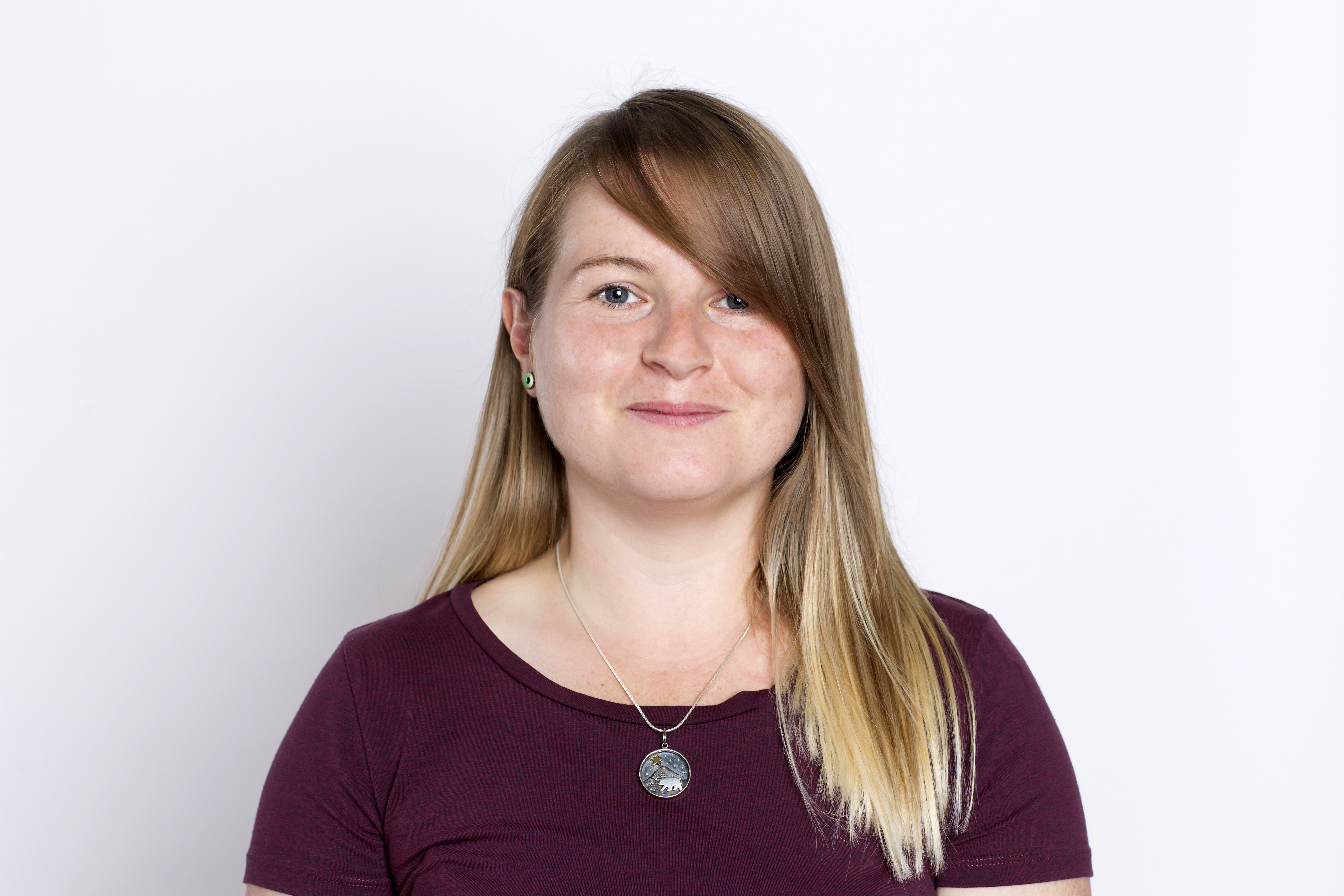
Jemma Davies, Development and Design Manager shares more about ASDAN’s approach to accessibility:
“Accessibility is one of the core pillars of all development and design projects at ASDAN,” says Jem. “We are continually learning about ways to make our courses and materials more inclusive – whether that’s adjusting our colour palettes, introducing new typefaces or looking at the underlying course structure. It’s so satisfying to look at how our designs have changed over the last five years and to see how we are improving.
“We recognise that this is a journey and that there are still lots of things we want to get better at,” says Jem. “Our aim is to be more accessible today than we were yesterday, and we really welcome any feedback or suggestions from our members.”
ASDAN materials are designed for teachers, by teachers
In order to get the best outcomes from our learners, we believe it’s vital to involve those who deliver our courses in the design and development process.
As a learning organisation, we are constantly evolving our programmes and approaches to engage, elevate and empower young people in their own education.
We recently recruited a new member to the PDD team, Angharad Crane, who previously worked in our customer service team and has 12 years’ of experience in teaching ASDAN courses in the classroom. Angharad’s insight into both our members’ needs and what works within a learning environment will be invaluable to ASDAN’s programme developments.
What are we currently working on?
We’re working on a pilot for Moving On, our latest programme aimed at young people leaving care. The Moving On journals have been designed with illustrations alongside text to emphasise key concepts. This technique is called dual-coding, which helps reinforce meaning. This is really helpful for young people who struggle with reading and for learners where English is not their first language.
Moving On pilot member, Jamie Diwell, recently shared her experience of ASDAN’s courses over her career:
“I've noticed over the last few years ASDAN has designed more materials for children who don't fit the linear progression path. A lot of our children have been let down by the education system. I feel like ASDAN is that net that catches these young people,” says Jamie.
If you’d like to share your experience of ASDAN’s courses, please get in touch at design@asdan.org.uk. We appreciate any feedback on what works for you and your learners and what could be improved to better young people’s access to education.
